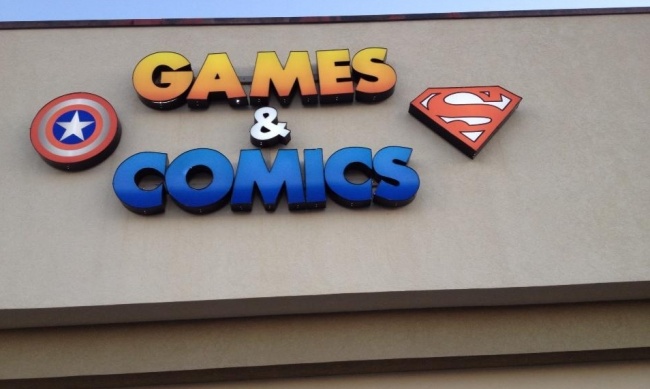View from the Game Store is a bi-weekly column by Marcus King, Director of Retail Operations at Troll and Toad Games & Comics in London, Kentucky. This week, King follows up his recent column on the economics of buying collections from customers (see “View from the Game Store – Greed Is Good”) with one on dealing with the people issues when people are trying to sell collectibles.
"The problem with the Internet is not that it educates customers. The problem is that it makes customers think they’re educated." -- Marcus King.
When I was eight years old, in the third grade, I was a dealer. A collectible coin dealer. I dealt in pennies, nickels and dimes. This was 1969. I bought Indian pennies and buffalo nickels for 10¢ each, and I bought mercury dimes for 20¢. I bought them from my classmates. I was always checking everyone's change, and I always carried a couple dollars in dimes and quarters with which to make my purchases. Every couple weeks my Dad would take me to the coin shop in Battle Creek, Michigan so I could buy and sell coins.
I collected U.S. and Canadian pennies from large cents through the current stuff. I had books to put them in, and carried a list of what I needed. My father would occasionally buy me an expensive coin for my collection, but the others I got with the profits from buying and selling coins.
My first lesson in condition on my collectibles was that many buffalo nickels had the dates completely worn off them, and were, therefore, only a nickel, never worth more. Another was that the ones with older dates and with the S mint mark tended to be more valuable. Any readable date on such a coin would get me 20¢ per coin, so I would double my money if I bought only the best ones. And sometimes, depending on date and condition, I could get up to $20 for a single coin.
Over the first couple years I learned what to look for in Lincoln and Indian pennies, buffalo and V nickels, and in the dimes. I expanded into buying quarters the next year, and then half dollars and old silver dollars in the following years.
I have been dealing in coins now for 47 years.
I have been dealing in comics for 45 years.
Antique books for 35 years.
Used video games for 29 years.
I also deal in other items. But, I came by my knowledge base the old fashioned way--by doing it.
I know how to spot a faked coin (I bought a few fakes along the way), and I know how to tell a valuable comic book from a similar looking, but worthless, reprint.
And yet, on a weekly basis, I get someone who has something they think is a valuable heirloom, but is just a cheap knockoff, reprint or trinket which resembles the genuine article.
As a dealer in rare collectibles I have to be able to spot those things. More importantly: I have to know how to break this bad news to a customer who believes they are holding the HOLY GRAIL of collectibles, and that I am refusing to make an offer on it because I am somehow swindling them.
News flash: Nobody ever ripped you off by REFUSING to buy your item.
The proliferation of TV shows like Pawn Stars, Hard Core Pawn and Comic Book Men gives customers the knowledge that their items may be worth some cash. This is good. According to the stories I have heard, at least 50% of mothers in America have thrown away $100,000 card and comic collections. So it’s good that people realize that things are valuable – or potentially so.
The rub comes in when the customer looks up their collection online and mis-identifies, or mis-grades it.
For example, Fantastic Four #1 from 1961 has a value ranging from $2500 to $50,000 (or more). But, when people find the badly worn and mice-chewed copy they had as a kid in their attic, they immediately assume it is worth $50,000; and when I make a very fair offer of $1800 for their $2500 comic, I am suddenly trying to rip them off. Better yet is when someone finds a much later reprint or a new series (there have been new Fantastic Four #1's printed more than a dozen times), which are worth maybe $5, and I refuse to make an offer because I have four copies in my dollar bin--I am still trying to rip them off.
Over the years, I have come to a process by which I simply ask the customer what they think their item is worth. If they think it is a $50K comic, and it isn't, I take them to a computer, bring up my grading guide, help them determine the right grade, then look those up for closed auctions on eBay. Once we determine what the actual value of the item is, I can sometimes make a deal. At least as often as I am successful with this process, I find that while the customer and I can agree the true value of the collectible is $4,000, they still want me to pay them $15,000 for it. Yes, this happens at least twice a month where someone wants me to pay them more than the determined value, because 'it's so rare!’
Of course, as a business owner I try to make sure everyone who enters my establishment leaves happier than when they came in. But, at the point a customer wants me to pay more than the full value of their collectible, this may not happen.
At which point, I print them out an appraisal form, tell them that usually I charge $250/hour for appraisal work, but that I am giving them the appraisal for free. Sign the form, and wish them a successful search for someone to buy their item.
As it turns out, even though I have dozens of years of experience in buying and selling collectibles, there are people who come into my store who need help I am just not qualified to deliver. One must recognize when further negotiations will just damage your relationship with said customer.
That's my 2¢ piece worth of advice for the week.
Follow me on Facebook if you liked this column.
The opinions expressed in this column are solely those of the writer, and do not necessarily reflect the views of the editorial staff of ICv2.com.

Column by Marcus King
Posted by Marcus King on October 28, 2015 @ 4:19 pm CT



